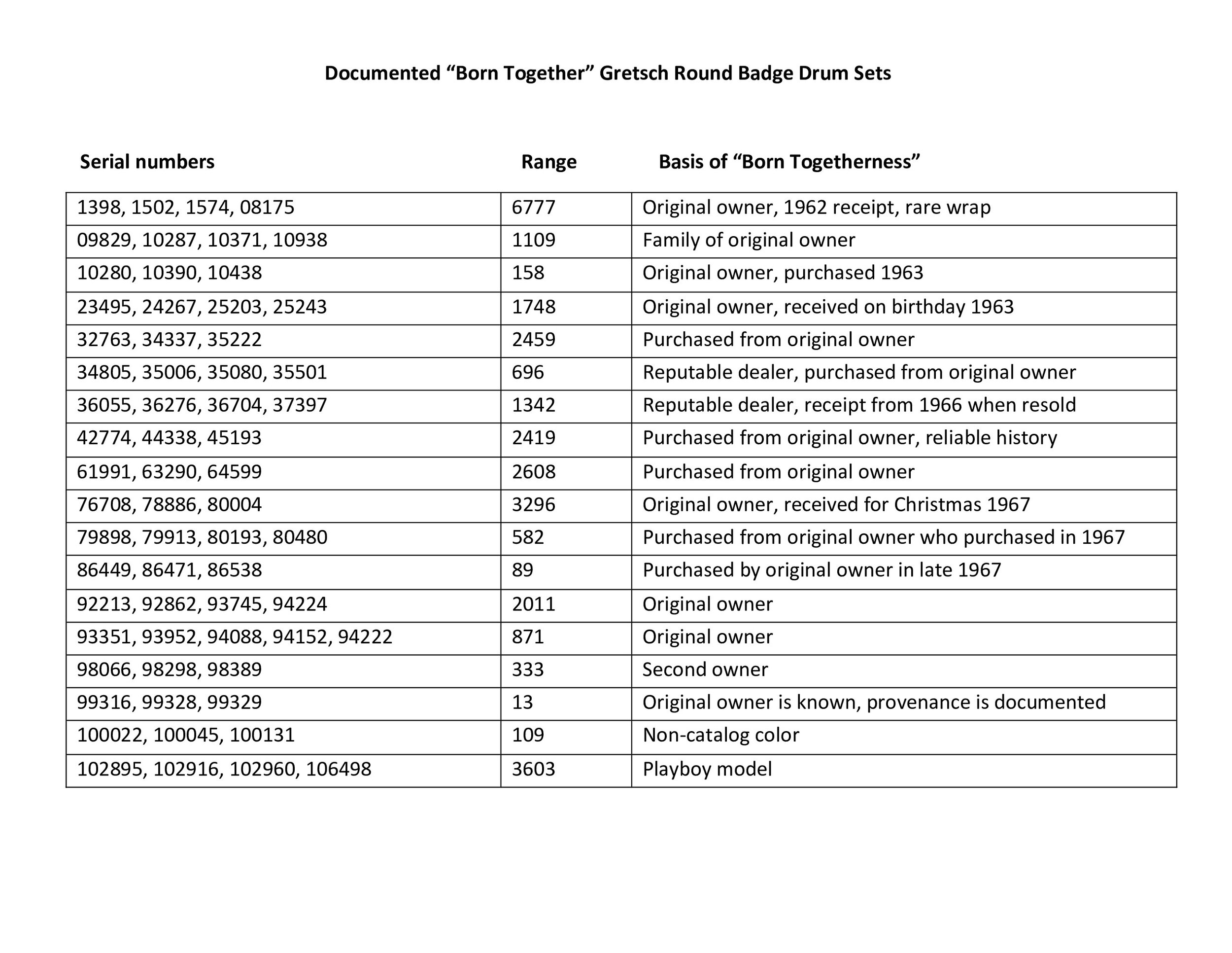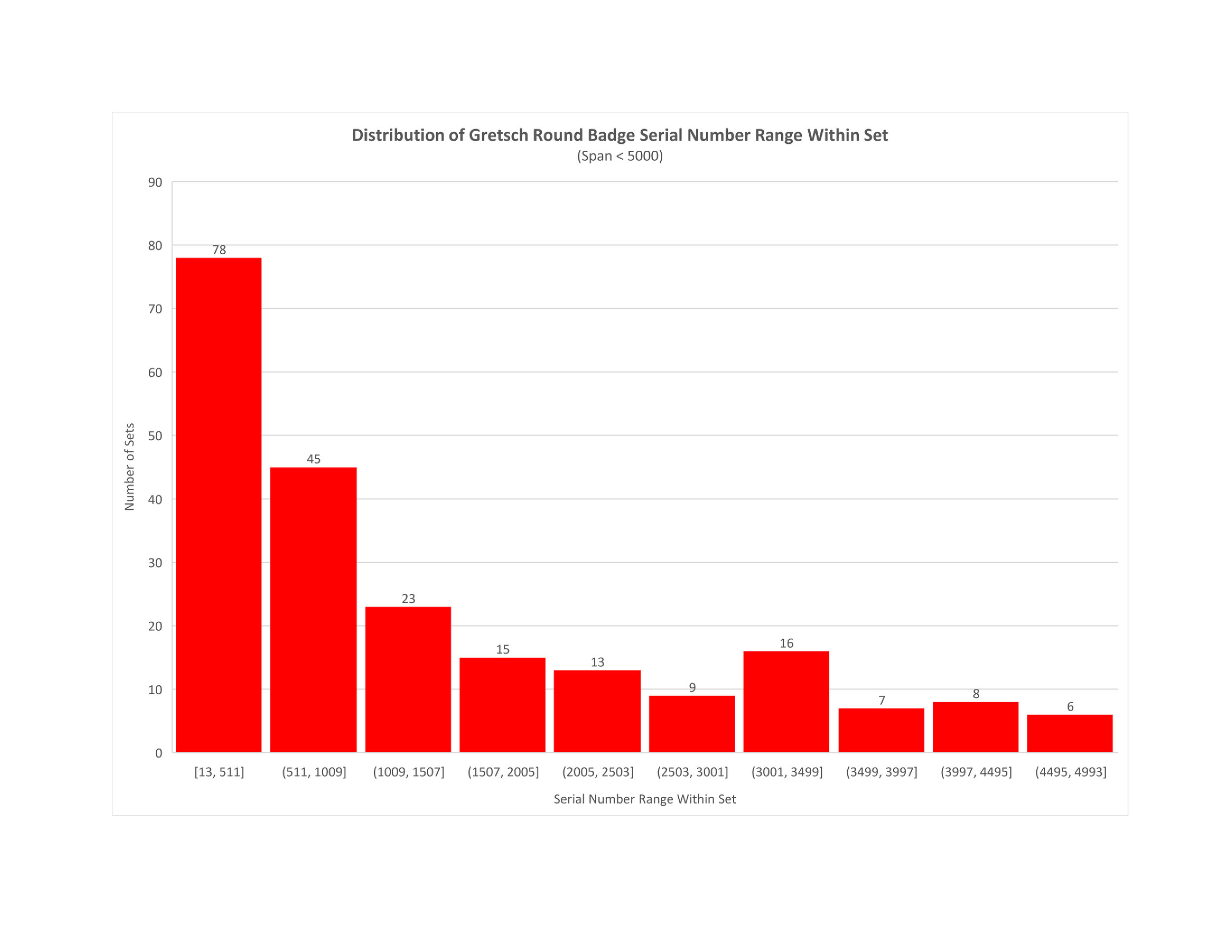Many collectors place a premium on “born together” drum sets - sets which were originally purchased as one unit from the factory or music instrument retailer. This study identifies vintage Gretsch Round Badge sets demonstrated or purported to be born together to establish an objective benchmark for determining that a set of drums was born together.
It is important to first understand the nature of Gretsch’s use of serial numbers in its Round Badge drums. Although there are no 1960s Gretsch production records to examine, it is widely believed that Gretsch issued and applied paper labels with serial numbers in roughly sequential order.[1] Further, there is solid indication that batch production methods, at least in the stamping and issuance of paper labels, resulted in groups of consecutive serial numbers being applied to the same model number of drum and not to the multiple models of drums which constitute a drum set. Therefore, one should not expect to see consecutive serial numbers within a set unless they have two of the same size drum in them.[2] It appears that Gretsch did not intentionally assign sequential serial numbers to drums of different sizes within sets nor did it purposefully consider serial numbers when grouping drums together as a set for shipment to dealers. Additional variation may have been introduced by a retailer putting together drums in its inventory to meet customer requirements or turn stock.
Therefore, a certain amount of difference between serial numbers within a born together set is expected. The question is how large of a serial number range can a set exhibit and still be considered to have likely been born together. As a general rule, vintage drum enthusiasts look for a relatively small span of serial numbers between the various drums in the set as evidence of born together status. However, one should be careful to let the desire for very close proximity in serial numbers triumph over the reality of Gretsch’s production and warehousing practices. Without an established standard, it is a judgment call on the part of the potential buyer, owner or appraiser regarding what constitutes an acceptable span.
The most reliable information for this study is from sets which possess a high certainty that they were originally purchased together. Over fifty years after they were made, only a small number of sets are still in the hands of their original owners or their family members. Other sets are accompanied by their original receipts or possess seemingly reliable histories which demonstrate their “born togetherness.” I reviewed a list of 3,935 Gretsch Round Badge drums, which represents about 3.4% of the roughly 116,000 Gretsch Round Badge drums which had serial numbers made from about 1962 through about 1969. From this list, 18 examples of sets reliably documented to have been born together are identified and shown on the table connected to this article.
Observations based upon these 18 sets:
1. All of these sets exhibit serial number ranges of less than 7,000
2. Only one set has a range above 4,000; only three sets have ranges above 3,000.
3. The average (mean) serial number range is 1,679 and the standard deviation of 1,708.
4. Only two sets exhibit ranges of serial numbers below 100.
5. One of the sets possesses two drums with consecutive serial numbers.
If forced to create rules based upon only these 18 examples, one could perhaps conclude that a serial number range of less than 3,000 - 4,000 should be expected in a born together set and non-consecutive serial numbers are the norm and not the exception. However, it seems risky to draw conclusions about all Gretsch Round Badge drum sets based upon only these 18 examples. Therefore, the pool of sets studied is increased by considering sets which exist today which appear to have been grouped together originally, but do not have the documentation required above.
To create the larger group of likely born together sets, information from partial or complete drum sets is taken from reports from current owners and advertisements on internet sites including eBay, Reverb and Facebook. Many of the reports about these sets contain express representations that they were born together, although most of these claims are not supported by verifiable documentation or supporting information like the select group of 18 drums examined above. Other sets are merely presented together with no claims as to their origin. Although a lack of born together claim is often likely due to a gap in knowledge about the history of the drums, in some cases it masks the cobbled together nature of the drums in the set. Sets with drums which are disclosed as pieced together are not considered. Neither are drums which are acknowledged to have been added to existing sets, although the original set may still be included.[3] Others are not included based upon subjective factors such as inconsistent physical features of the drums, inconsistent degree of fade in finish, lack of overall originality of the drums, and the reputation of the seller/owner of the drums. Also disregarded are groups of drums with fewer than three serial numbers, either because not all serial numbers are reported or the set has only two drums. Finally, sets which possessed serial number ranges above 25,000 are also excluded from the study group as not likely to be born together, as this represents about two years of production and serial number usage during the round badge era. Excluding sets based upon a large serial number range when attempting to identify an expected serial number range requires a bit of circular logic, but at this stage, this approach errs on the side of inclusion rather than exclusion. It is more likely that some sets which were not born together are included than some which were born together are excluded. The resulting list of 304 sets appears by several indicators to be an appropriate group for further study.[4]
The first graph (with blue bars) shows the distribution of these 304 sets. It is very biased towards the left side, with lower serial number ranges far outnumbering the larger ones. Almost three-quarters (220 of 304, or 72%) of the drums were in sets which had serial number ranges of 5,000 or less. This leaves a relatively small number of sets (84) with serial number ranges above 5,000. It seems to support that at least some of these sets were not likely to have been born-together. The steep rate as which the numbers drop off as one increases the serial number range in groups of 5,000 seems to echo this conclusion.
The next step is to cull from the study group some sets included in the initial group of 304 which have larger serial number ranges. The 5,000 point seems like a reasonable cut off point for further analysis. Serial numbers were used at roughly a rate of 13,000 a year, so this would represent something like five months of production. Reducing the study to just these 220 drum sets may exclude a few born together drum sets, but also likely excludes a large number of sets which are not born together and therefore are not appropriate for this study. This group of 220 drums, shown in the second graph (with red bars), is also left side biased, although not as much as the first graph. More than half (123 of 220) of the sets with ranges below 5,000 have ranges below 1,000. If one includes sets with serial number ranges of 2,000 or less, almost three-fourths (161 of 220) of the sets are included. Alternatively, if one continues to consider all sets up to the serial number range of 25,000, one must include sets with ranges up to 2,000 to include half of the total sets (161 of 304, or 53%) and sets with ranges up to 4,000 to include two-thirds (206 of 304, or 68%) of the sets.
Culling the number of sets analyzed further results in a less left biased and much more evenly spread, indicating that the culling has perhaps gone too far. A variety of groupings was considered, with the 25,000 and 5,000 ranges discussed above considered to be the most representative and instructive.
The appropriate benchmark for the span of serial numbers for born-together sets appears to be about 4,000, which captures about two-thirds of the drums in the complete dataset, more than three-fourths of the smaller dataset and 17 of 18 sets which are solidly documented as having been purchased together. It should be noted that despite the attempt to quantify this benchmark with objective data, there is a certain amount of subjectivity to this number. Setting any strict benchmark risks the exclusion of some legitimate born together sets, so it should be considered a guideline and not a rule.
Regardless of the exact benchmark selected, the smaller the span of serial numbers is within a group of drums, it seems more likely that they were born together at the factory. This is consistent with the strong tendency toward the issuance of serial numbers in roughly sequential order and echoes the basic rationale used by most vintage drum enthusiasts.
Comments and suggestions for further analysis are welcome. Contact the author at Rick@GretschDrumDatingGuide.com.
[1] Richard E. Gier, Dating of Vintage Gretsch Drums Based Upon Serial Numbers – Challenging the Legend, Lore and Lies, Rebeats Publications, Alma, MI, 2011.
[2] Six consecutive numbers are present in this study - five Rock and Roll configurations which possessed twin 8x12” toms and one double bass set. In all six, the consecutive serial numbers were on the same sized drums.
[3] For example, floor toms with serial numbers drastically different from the remaining drums in the set are not considered, as later adding a floor tom to an original set consisting of a tom, bass and snare seems to have been a common practice.
[4] Note that the 18 sets discussed above as documented as born together are included in this group of 304 sets.



